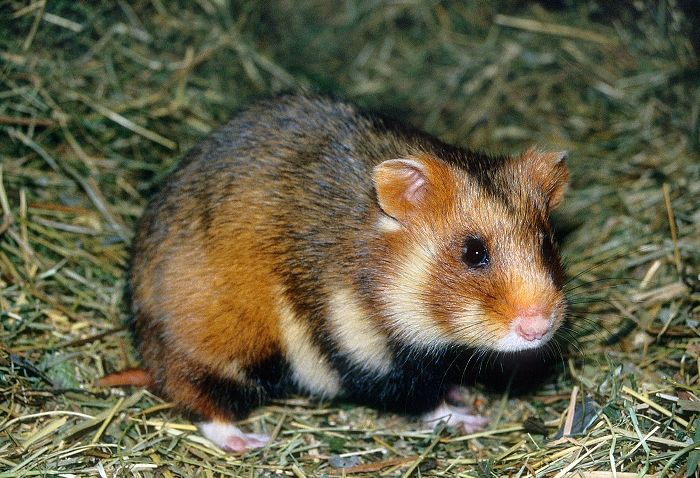
European hamster, or Eurasian hamster, or Black-bellied hamster, or Common hamster(Cricetus cricetus)
Phylum —chordata
Class — mammalia
Order — rodentia
Family — cricetidae
Genus – cricetus
Appearance
The European hamster has brown dorsal fur with white patches. The chest and belly are black. The tail is short and furred. It is much larger than the Syrian or Dwarf hamsters, which are commonly kept as pets. It weighs 220–460 g (7.8–16.2 oz) and can grow to 20–35 cm (8–14 in) long with a tail of 4–6 cm (1.6–2.4 in).
Habitat
European hamsters are native to a large range in Eurasia. They are found from Belgium and Alsace (eastern France) in the west, to Russia in the east, and Bulgaria in the south.
Behavior
European hamsters are usually solitary and crepuscular creatures. They live in a complex burrow system. Having elastic cheek pouches these hamsters transport their food to the food storage chambers. These may be quite large and may consist of a total of 65 kg of food including. European hamsters hibernate between October and March. During this time, they wake up every 5-7 days to feed from the storage chambers. These hamsters are good simmers. When a hamster needs to swim it inflates its cheek pouches with air for increased buoyancy. Sometimes during large population movements European hamsters can cross large rivers. These movements are usually caused by food shortages.
Diet
European hamsters are omnivores. They eat seeds, legumes, root vegetables, grasses, and insects.
Reproduction
Little is known about the mating system in European hamsters. They breed from early April to August. Females usually give birth to 2 litters per year and the size of the litter ranges from 3 to 15 young. The gestation period lasts 18-20 days. Young are weaned at 3 weeks of age and reach adult size at 8 weeks. Adult European hamsters reach reproductive maturity when they are about 43 days old.
In captivity
In captivity, the European hamster has an unusually long lifespan, living up to eight years.
The hamster does not need special conditions of keeping it at home. He always feels good. It eats whatever it wants, however it wants - and how it eats: it sits on its hind legs, and its paws are very similar to human hands; it appetitively sucks food first by one cheek, then by the other, turning into a charming fluffy ball. But in no case do not touch its cheek bags with hands and certainly do not apply any physical effort to touch it while eating. This will cause the animal unpleasant sensations, despite the fact that these bags are incredibly elastic.
Of course, the main and necessary condition for keeping a hamster is a cage. Preferably, if it is made of metal, but not of copper. The tree will not resist the teeth of small animals, the hamster will definitely chew a hole in the cage and get free. A free-roaming hamster is a threat to your well-being. Hamsters successfully chew through the back walls of cabinets, secretaries, linen drawers. In addition, they like to make their nests out of fur, fabric, paper - everything that comes under the teeth of this restless animal is used: books, dresses, shoes. From all troubles you will be saved by a cage, restriction of freedom of a hamster.
Hamsters are unpretentious in food. All that you eat yourself, you can safely give to your pet. Of course, that hamsters prefer different crops. They love flour products, bread and even dumplings.
If you are lucky enough to get fish oil - it is also recommended to add it to the food for 0.1 - 0.2 g. It makes sense to buy vitamins A, E and D in oil and add to drink or wet food 1 time a week for 1 drop per animal. Hamsters are very fond of meat, but do not give raw meat. Youcangive a smallamountoffat.
 Russian
Russian
 English
English
























